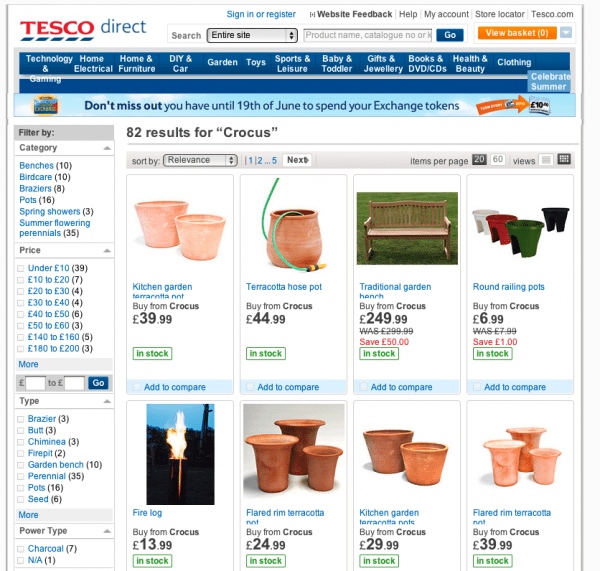An example of aligning the Tesco.com digital marketing strategy with retail growth strategy
I was recently speaking at the Internet Retailing Expo and when attending, I noticed Tesco announcing their online marketplace. This has now quietly soft launched in the UK.
This interested me as yet another sign of Tesco responding to online opportunities, in this case by opening a marketplace to sell products from other retailers as part of its Tesco Direct offering. Currently marketplace sellers aren’t explicitly featured as in Amazon product listings, instead, it’s folded into search results for some products:

It looks as if Tesco are testing how to best integrate the marketplace approach now, as part of a soft-launch.
Tesco marketing strategy - 7 core principles for growth
I was also interested that at the show Tesco talked about how the marketplace supported Tesco's core business strategy to support long-term growth. I thought it would be useful to present as often examples of business strategy are not usually published in annual reports and the like and it’s useful to learn.
Rather than creating a new strategy each year, Tesco has a series of common strategy elements that it adds to each year. The online marketplace initiative is one example of this.
It's well-known that Tesco is not currently delivering the financial performance it has previously, the original strategic principles were set out in 1997 when Tesco set out a strategy to grow the core business and diversify with new products and services in existing and new markets (some of you will recognise these strategic goals as part of the review using the Ansoff matrix). It's a good example of strategy development because of the focus on where growth is going to come from.
Since then, this strategy enabled Tesco to grow by entering expanding markets in the UK – such as financial services, general merchandise and telecoms – and new markets abroad, initially in Europe and Asia and more recently in the United States. The strategy now has seven parts and is refined to apply to our five business segments – the UK, Asia, Europe, the United States and Tesco Bank.
Here I will outline the main elements of the Tesco business strategy showing, where relevant, how it is aligned with digital strategy. This is a classic method of developing a digital strategy - to score different strategic options for digital marketing based on how well they align with the business strategy. Of course many companies won’t have such a clearly defined strategy which is another reason for presenting this example:
Growth strategy 1. To grow the UK core
The UK is still the largest business in the Group and a key driver of sales and profit. There are many opportunities for further growth and so growing the UK core.
Tesco Direct and the latest marketplace initiative are clearly aligned with this - Tesco has seen the growth of Amazon and eBay marketplace and is responding to these.
Growth strategy 2. To be an outstanding international retailer in stores and online
This was another the original goals from 1997 - to be a ‘successful international retailer’. In 1997, international businesses generated 1.8% of the Group’s profits, today they represent 25%.
Notice that the online channel is explicitly mentioned as supporting this strategy.
We can expect that if successful in the UK, the marketplace concept will be rolled out in other markets too.
If you want to find out more about how Tesco supports this strategy through technology I recommend following Nick Lansley’s Tech for Tesco blog. Nick was originally involved in the creation of Tesco.com and these days looks at emerging technologies such as mobile.
Growth strategy 3. To be as strong in everything we sell as we are in food
The Tesco Direct and marketplace strategy also supports this
Growth strategy 4. To grow retail services in all our markets
Non-food services like Telecoms and Banking now account for 16% of Group total although these are mainly implemented in the UK. Tesco now say that as many of their international businesses are established, well-known brands in their local market, they aim to grow these further.
Growth strategy 5. To put our responsibilities to the communities we serve at the heart of what we do
This was added in 2007; it’s apparently a response to negative perception about the brand an a corporate social responsibility push. There’s little evidence of this being supported online at a local level - the online presence is still overwhelmingly commercial. However Tesco does run wider CSR initiatives such as the Tesco charity of the year.
Growth strategy 6. To be a creator of highly valued brands
Tesco say: “Our brand has evolved from a logo above a few stores in the UK to a multitude of store, product and service brands across the world. Building brands gives our business more meaning with our customers. On one level, this relates to our Retail brands such as the Tesco brand itself, but it also refers to our Product brands such as F&F and Technika and our Pillar brands such as Finest and Value”.
You can see this relates to development of sub-brands to fit specific market needs. Finding methods to add value to brands is at the heart of all effective digital strategies, so we can expect Tesco expect their brand managers to use digital in this way.
Growth strategy 7. To build our team so that we create more value.
It seems that by team, Tesco refer to leaders to help build the team and achieve growth rather than building a team of all employees. Again, there’s little evidence of this push online.
So, that’s the summary of the Tesco business strategy, at least the public-facing strategy. I think it shows the need for clarity in strategy and my main point, that digital strategy must be shown to support business strategy to get the recognition and resourcing it needs to be effective.








